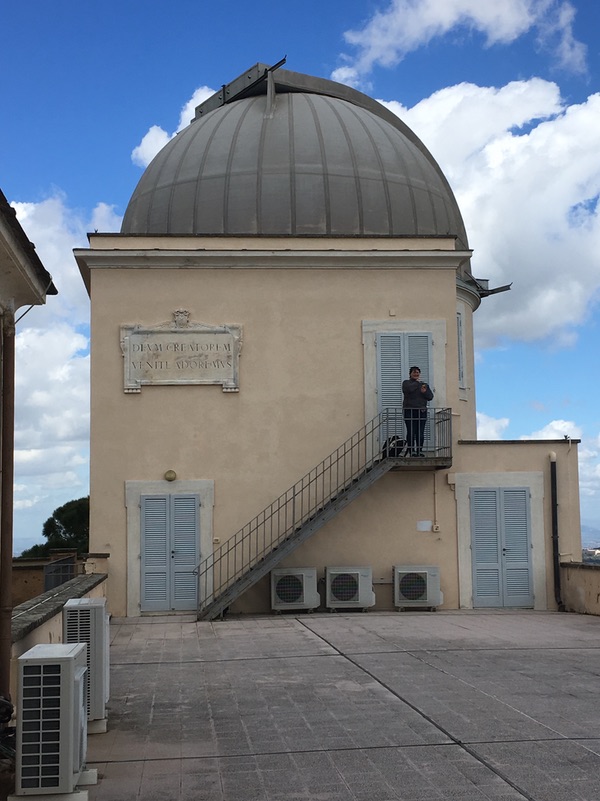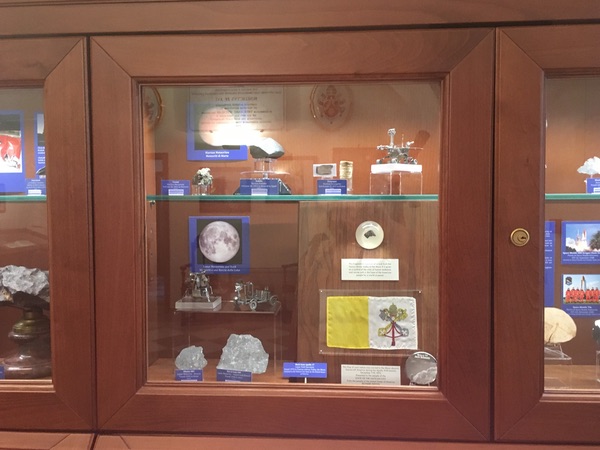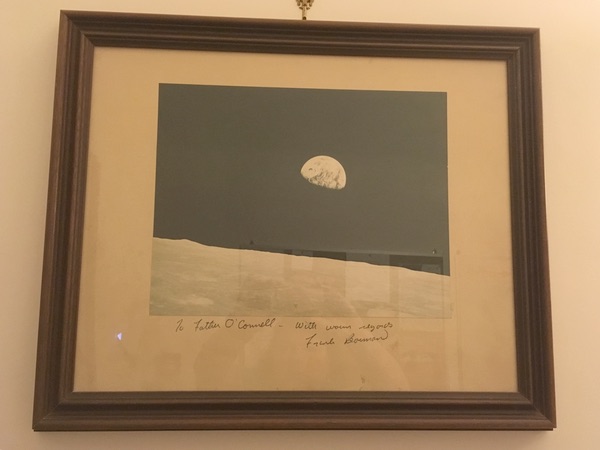The NASA-Vatican relationship models a bridge between science and religionby Deana L. Weibel
|
| I was able to conduct ethnographic research while staying at the Vatican Observatory this spring and was intrigued to find numerous connections to the Apollo missions. |
Although Paul VI was not the only head of state to cite scripture in his goodwill message (President Zalman Shazar of Israel quoted from Psalms 72, 7),[4] his physical location during the Apollo 11 landing was one with a unique perspective, a place whose existence makes the case for the basic compatibility of religion and science. In fact, the Vatican Observatory, whose current incarnation was founded in 1891 by Pope Leo XIII, had an initial goal of demonstrating that the “Church and her Pastors are not opposed to true and solid science…but…embrace it, encourage it, and promote it with the fullest possible dedication.”[5] The Vatican’s particular relationship with space exploration, a relationship solidified by the existence of the Vatican Observatory, sets it apart from many other groups.
Ministers from the Southern Christian Leadership Conference (SCLC), for example, were among those who protested the launch of Apollo 14 in January 1971, taking the view, like many other African-American civil rights groups at the time, that the resources used for lunar missions would be much better spent elsewhere. As SCLC’s Reverend Hosea Williams stated, “We are not protesting America’s achievements in outer space, we are protesting our country’s inability to choose humane priorities.”[6] A different perspective, one that suggested not that humans shouldn’t go to the Moon, but couldn’t go to the Moon, was expressed by Elder Joseph Fielding Smith of the Church of Jesus Christ of Latter-Day Saints. In 1961 he proclaimed, “We will never get a man into space. This earth is man’s sphere and it was never intended that he should get away from it. The moon is a superior planet to the earth and it was never intended that man should go there. You can write it down in your books that this will never happen.”[7] (Elder Smith later admitted he was wrong, and in September 1971 astronauts from the Apollo 15 mission presented him with a Utah flag that had accompanied them to the Moon.)[8]
 One of the Vatican Observatory’s telescope domes. |
As an anthropologist whose work focuses on sacred places and how people think about them, religious interpretations of outer space (“the heavens”) are very interesting to me. I was able to conduct ethnographic research while staying at the Vatican Observatory this spring and was intrigued to find numerous connections to the Apollo missions. I toured the observatory dome where Paul VI witnessed the Apollo 11 landing (marked with a photograph taken that day), but the observatory’s offices and public spaces show a deeper relationship. Photographs signed by Apollo astronauts occupy prominent positions and wooden display cabinets hold such objects as a small Vatican flag that was taken by the crew of Apollo 17 to the Moon and returned to the Holy See, transformed (at least symbolically) by its time on the lunar surface. The flag sits below a sample of lunar rock from the Moon’s Taurus-Littrow Valley, retrieved by the same crew and given to the people of Vatican City. An impressive, electrically-lit moon globe, marked with potential Apollo landing sites, is also on show, donated to Pope Paul VI by Thomas O. Paine, who served as NASA’s Administrator from March 1969 to September 1970.
The connection to Apollo is not merely historical. The Vatican Observatory is well known for its meteorite laboratory, a site where various types of planetary geology research take place, and scholarship on the composition of Moon rocks retrieved on the Apollo missions continues there. One of the Jesuit astronomers showed me around the lab, noting his careful handling of the lunar specimens, whose dusty residue must be cleaned according to strict NASA guidelines. His work with the Moon rocks led to a publication while I was there, requiring him (by custom) to bring a celebratory tray of pastries to the daily gathering for cappuccinos and conversation. The Vatican Observatory is a place where science is conducted, but also where a relationship between science and religion is valued, nurtured, and sustained.
 Wooden display cabinets hold such objects as a small Vatican flag that was taken by the crew of Apollo 17 to the Moon and returned to the Holy See, transformed (at least symbolically) by its time on the lunar surface. The flag sits below a sample of lunar rock from the Moon’s Taurus-Littrow Valley, retrieved by the same crew and given to the people of Vatican City.
|
The perspective of the Catholic church on scientific matters is far from flawless, with ideology sometimes delaying the acceptance of expert consensus. The Vatican Observatory, however, because of its commitment to remaining scientifically relevant in the fields of physics, planetary geology, and astronomy, provides a model for a harmonious relationship between science and religion. This model may prove useful as topics like abortion rights, vaccines, gender identity, medical research, and climate change threaten to amplify the existing tensions between religious and scientific ways of knowing. As fierce and unyielding as this estrangement may seem, looking beyond doctrine to actual practice is revealing. In real life, people often just go ahead and combine religion and science as they carry out their varied missions, whether it be Buzz Aldrin taking communion on the Moon,[9] a rabbi commissioning a miniature Torah to fit into a space-bound congregant’s Personal Preference Kit,[10] a flight engineer heading to the International Space Station with a copy of the Baghavad Gita and a statue of Lord Ganesh,[11] or a Vatican astronomer carefully putting away Moon rocks that were gathered 50 years before, then locking up his laboratory and heading to an evening Mass.
Endnotes
- Sarah Loff, “Apollo 11 Mission Overview,” NASA, April 17, 2015, accessed June 9, 2019.
- “Pope Paul VI at the Vatican Observatory for Apollo 11,” Vatican Observatory Foundation Faith and Science, June 04, 2019, accessed June 9, 2019.
- National Aeronautics and Space Administration, News, “Apollo 11 Goodwill Messages,” news release, Washington, DC, 1969 (NASA).
- Ibid.
- Agustín Udías, Searching the Heavens and the Earth: The History of Jesuit Observatories (Dordrecht: Springer, 2011).
- “Blacks Protest Apollo 14 Shot,” Rome News-Tribune (Rome, Georgia), February 2, 1971.
- D. Michael Quinn, Elder Statesman: A Biography of J. Reuben Clark (Salt Lake City, UT: Signature Books, 2002).
- Hal Knight, “3 Apollo Astros in S.L. For Busy One-Day Visit,” Deseret News (14 September 1971).
- Deana L. Weibel and Glen E. Swanson, "Malinowski In Orbit." Quest 13, no. 3 (2006).
- Deana L. Weibel, “Pennies from Heaven: Objects in the Use of Outer Space as Sacred Space.” Touching the Face of the Cosmos: On the Intersection of Space Travel and Religion.
- “Sunita Williams Takes off with Ganesh, Gita, Samosas,” DNA India, December 10, 2006, accessed June 12, 2019.
Note: we are temporarily moderating all comments subcommitted to deal with a surge in spam.
